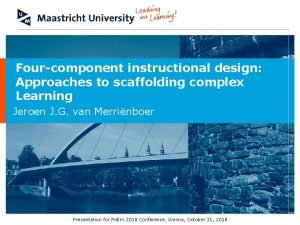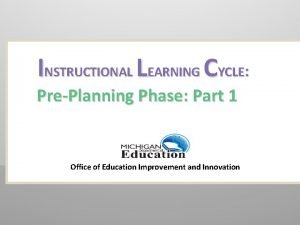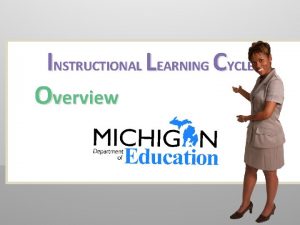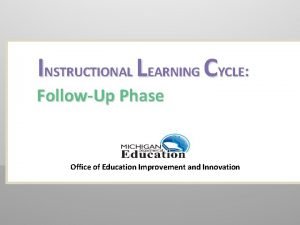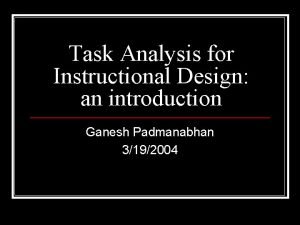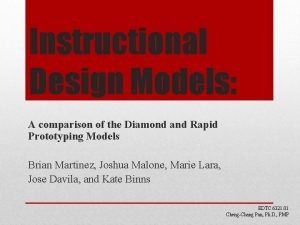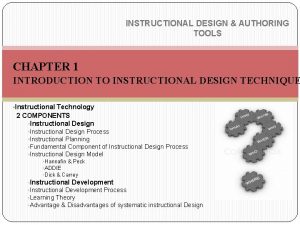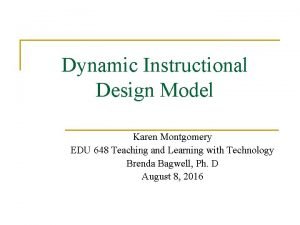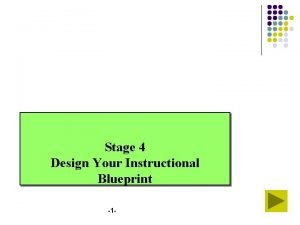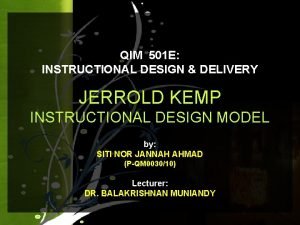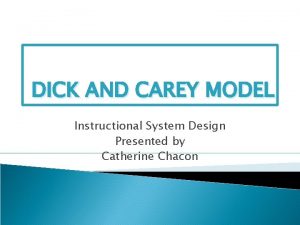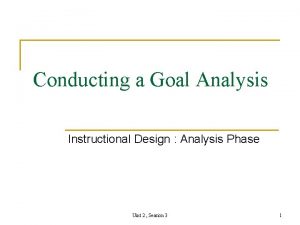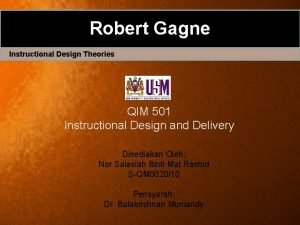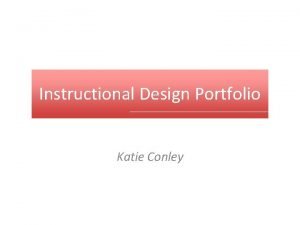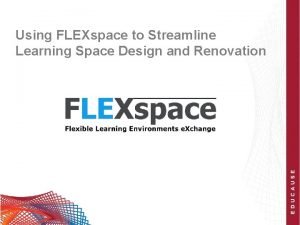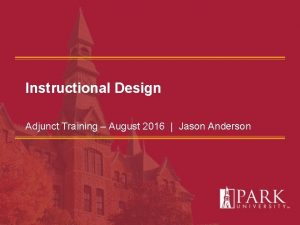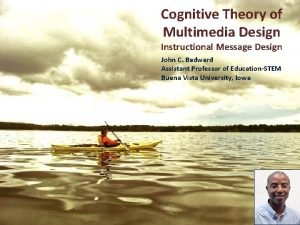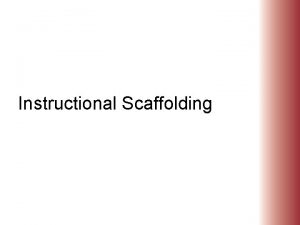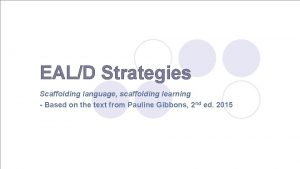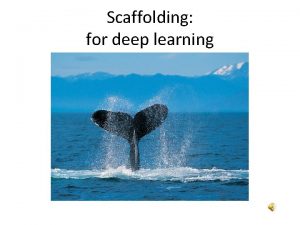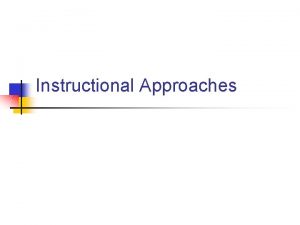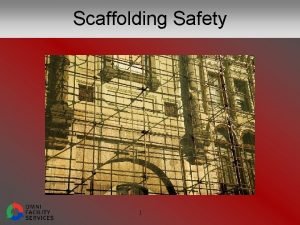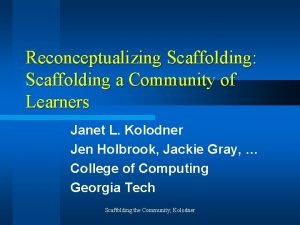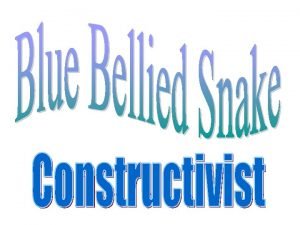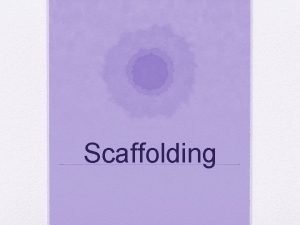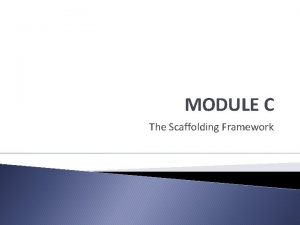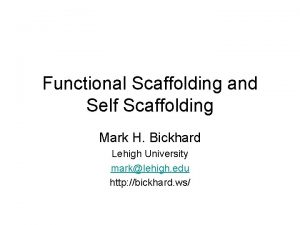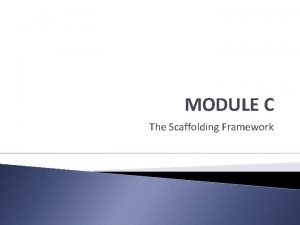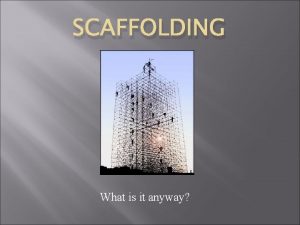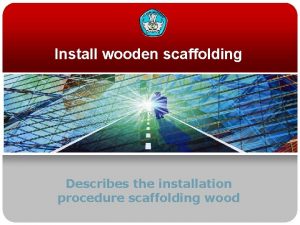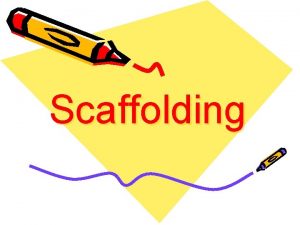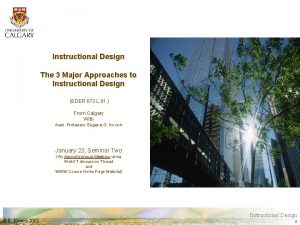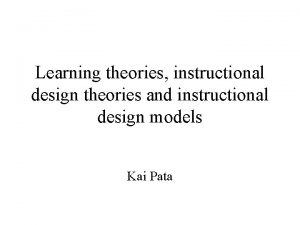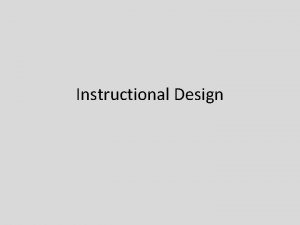Fourcomponent instructional design Approaches to scaffolding complex Learning


























- Slides: 26

Four-component instructional design: Approaches to scaffolding complex Learning Jeroen J. G. van Merriënboer Presentation for Po. Em 2018 Conference, Vienna, October 31, 2018

Contents • Why change education? • 4 C/IDfour-component instructional design • Scaffolding complex learning – Support – Guidance • Use of learning technologies • Discussion & questions FHML – Dept. of Educational Development and Research – School of Health Professions Education

Why Change Education? Students are not able to apply the things they have learned in –quickly changing– work settings. . . Compartmentalisation → integration Fragmentation → coordination Transfer paradox → differentiation FHML – Dept. of Educational Development and Research – School of Health Professions Education

From compartmentalisation toward integration Which architect do you prefer? 1. Knows all about design but is not able to make technical drawings 2. Has excellent technical drawing skills but is unfriendly to his clients and customers 3. Is friendly but did not update his professional skills after his graduation 20 years ago 4. None of the above FHML – Dept. of Educational Development and Research – School of Health Professions Education

From fragmentation toward coordination Atomistic models • Analyse complex learning domain in small pieces • Teach piece-by-piece Holistic models • Analyse complex learning domain in coherence; focus on relations between pieces • Teach from simple wholes to complex wholes 1+1=3 FHML – Dept. of Educational Development and Research – School of Health Professions Education

From the transfer paradox toward differentiation Students learn to diagnose 3 errors. . . • Practice E 1 -E 1 E 2 -E 2 E 3 -E 3 Reach goals fast but low transfer (not able to diagnose E 4) • Practice E 2 -E 3 -E 1 E 3 -E 2 -E 1 -E 3 Reach goals slower but high transfer (able to diagnose E 4) FHML – Dept. of Educational Development and Research – School of Health Professions Education

4 C/ID – Four Components 1. Learning tasks – 1997 Backbone of educational program 2. Supportive information 3. Procedural information 4. Part-task practice 2018, 3 rd Ed. FHML – Dept. of Educational Development and Research – School of Health Professions Education

1 Learning Tasks Problems, projects, tasks, assignments, cases etc. • Often based on real-life tasks • Integrative: professional competencies • Inductive learning FHML – Dept. of Educational Development and Research – School of Health Professions Education

1 Learning Tasks - Variability • Variability is critical to reaching transfer of learning – Surface features – Structural features FHML – Dept. of Educational Development and Research – School of Health Professions Education

1 Learning Tasks – Task Classes • Sequence from easy to difficult • Meaningful right from the start • Need variability in each task class FHML – Dept. of Educational Development and Research – School of Health Professions Education

1 Learning tasks – Support and Guidance • Scaffolding in each task class • Zone of ‘proximal development’ • Sawtooth pattern of support FHML – Dept. of Educational Development and Research – School of Health Professions Education

2 Supportive Information • Problem solving and reasoning aspects – How is the domain organized? – How to approach tasks in the domain? • Elaboration FHML – Dept. of Educational Development and Research – School of Health Professions Education

3 Procedural Information • Routine aspects • ‘How-to’ information, just-in-time • Knowledge compilation FHML – Dept. of Educational Development and Research – School of Health Professions Education

4 Part-task Practice • Cognitive context • Repetition • Strengthening FHML – Dept. of Educational Development and Research – School of Health Professions Education

4 C/ID and learning processes Schema construction SYSTEM 2 Schema automation SYSTEM 1 Inductive learning 1. Learning tasks Elaboration 2. Supportive information Knowledgecompilation 3. Procedural information Strengthening 4. Part-task practice Van Merriënboer, J. J. G. (2013). Perspectives on problem solving and Education, FHML – Dept. of Educational Development and Research – Schoolinstruction. of Health Computers Professionsand Education 64, 153 -160.

The Integrated Curriculum FHML – Dept. of Educational Development and Research – School of Health Professions Education

Scaffolding complex learning • From high to low (built-in) task support • From high to low guidance FHML – Dept. of Educational Development and Research – School of Health Professions Education

Newell, & Simon, H. A. Professions (1972). Human problem FHML – Dept. of Educational Development and Research – A. , School of Health Education solving. Englewood Cliffs, NJ: Prentice Hall.

Built-in task support • Completion strategy – 1 study example solutions (worked examples) – 2 complete partially worked out example solutions (completion tasks) – 3 generate complete solutions (conventional problems) – 4 go back to 1, but now on a higher level of complexity FHML – Dept. of Educational Development and Research – School of Health Professions Education

Other learning tasks with built-in task support • Reverse problems – Give goal and solution and ask in which given situations this solution is useful • Goal-free problems – Give given state and ask for possible goals and associated solutions • Imitation problems – Give given situation, goal and solution and ask for solution for similar a problem FHML – Dept. of Educational Development and Research – School of Health Professions Education

Guidance • Modeling examples – Show the problem-solving process for generating a solution (e. g. , expert thinking aloud) • Process worksheets – Provide phases and rules-of-thumb for successfully completing each phase • Performance constraints – Only allowed to continue after successfully completing a particular phase • Tutor guidance – Combines all of the above FHML – Dept. of Educational Development and Research – School of Health Professions Education

Use of Learning Technologies 1. Learning tasks Simulated/real task environments 2. Supportive information Hypermedia & multimedia Systems, Internet 3. Procedural information EPSS, on-line help sytems, mobile technologies 4. Part-task practice Drill & practice CBT, skillslab FHML – Dept. of Educational Development and Research – School of Health Professions Education

Double blended learning FHML – Dept. of Educational Development and Research – School of Health Professions Education

Is it Worth the Effort? • Teacher design teams design more effective and appealing courses with 4 C/ID • For professional competencies, whole-task practice yields higher learning outcomes than part-task practice • 4 C/ID-based courses yield higher learning outcomes and, especially, higher transfer of learning than “traditional” courses » For empirical evidence, see: Van Merriënboer, J. J. G. , & Kirschner, P. A. (2018). 4 C/ID in the context of instructional design and the learning sciences. In F. Fisher, C. E. Hmelo-Silver, S. R. Goldman, & P. Reimann (Eds. ), International Handbook of the Learning Sciences (pp. 169 -179). New York: Routledge. FHML – Dept. of Educational Development and Research – School of Health Professions Education

Discussion and Questions • Goal is transfer of learning • 4 learning processes, 4 components • Scaffolding = decreasing support & guidance • Rich use of learning technologies • Time- and effort-consuming design process, but worth the effort! FHML – Dept. of Educational Development and Research – School of Health Professions Education

www. 4 cid. org FHML – Dept. of Educational Development and Research – School of Health Professions Education
 Ask fhml
Ask fhml What is vygotsky's theory of scaffolding learning
What is vygotsky's theory of scaffolding learning Pre planning phase
Pre planning phase Instructional learning cycle
Instructional learning cycle Instructional learning cycle
Instructional learning cycle Task analysis instructional design
Task analysis instructional design The diamond model of curriculum development
The diamond model of curriculum development Instructional design authoring tools
Instructional design authoring tools Dynamic instructional design model
Dynamic instructional design model Disadvantage of assure model
Disadvantage of assure model Instructional blueprint
Instructional blueprint Assure modeli
Assure modeli Kemp design model
Kemp design model Dick and carey design model
Dick and carey design model Goal analysis instructional design
Goal analysis instructional design Assure model instructional design
Assure model instructional design Robert gagne theory
Robert gagne theory Katie conley model
Katie conley model Sam instructional design model
Sam instructional design model Streamline learning
Streamline learning Kemp's instructional design model
Kemp's instructional design model Instructional message design
Instructional message design Cuadro comparativo de e-learning b-learning y m-learning
Cuadro comparativo de e-learning b-learning y m-learning Bruno dislikes sitting on the beach
Bruno dislikes sitting on the beach Ghon complex and ranke complex
Ghon complex and ranke complex Complex and compound sentences quiz
Complex and compound sentences quiz The electra complex
The electra complex
